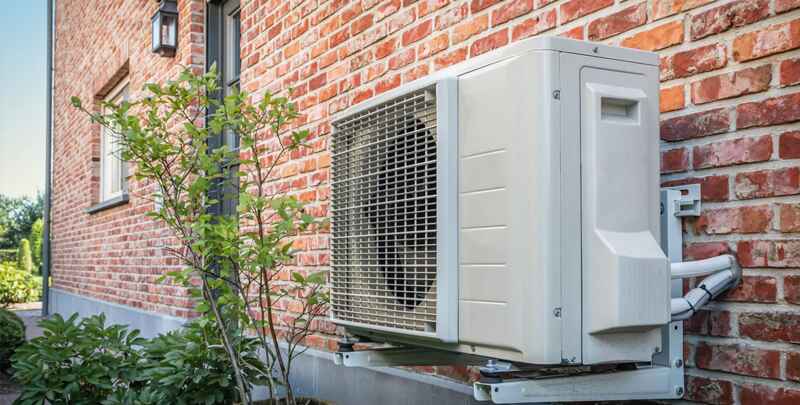A properly functioning air conditioner is essential for maintaining a comfortable and pleasant indoor environment, especially during the hot summer.
The right air conditioner is the unsung hero of our homes, silently working to keep us cool. But, like all mechanical systems, air conditioners can develop issues over time. Regular maintenance is crucial to ensure that your AC operates efficiently and reliably.
In this article, we’ll explore some common signs that your air conditioner isn’t working as it should and provide valuable insights into addressing these problems.
Common Signs of Air Conditioner Problems
Here are some of the common signs that your air conditioner isn’t functioning properly:
- Warm air blowing: One of the most noticeable signs that something’s amiss with your AC is when warm air starts blowing from the vents instead of the refreshing cool breeze you expect. This occurrence can be frustrating and uncomfortable, especially during scorching weather. Warm air from your AC typically indicates an issue with the cooling process. It may be due to a refrigerant leak, a malfunctioning compressor, or even blocked airflow. It’s essential to investigate this issue promptly to avoid further discomfort.
- Weak or insufficient airflow: Another red flag is weak or insufficient airflow coming from your split system air conditioner. When you notice that the whole split system air conditioner isn’t as efficient in cooling or circulating hot air as forcefully as other complete-new air conditioner split systems or single-room split system air conditioners, it can lead to uneven cooling and decreased comfort. Dirty or clogged air filters, obstructed ducts, or a malfunctioning blower motor can cause reduced airflow from the complete-size air conditioner and other split system systems. Addressing this issue can help improve the efficiency and effectiveness of your AC’s split system air conditioner.
- Unusual noises: Your air conditioner should operate quietly in the background, so any unusual noises should raise concerns. These sounds may include rattling, banging, hissing, or squealing. Each noise can indicate a different problem, such as loose components, damaged fan blades, or refrigerant leaks. Identifying the source of these noises is essential to prevent further damage and ensure a peaceful living environment.
- Foul odours: If your air conditioner emits unpleasant odours, it’s a nuisance and a potential health concern. Foul smells could result from mould or mildew growth within the AC system, dirty filters, or even a dead animal trapped in the ducts. Breathing in these odours can lead to respiratory issues. It’s vital to address this issue promptly for your well-being and comfort.
- Inconsistent cooling: Inconsistent heating mode cooling is a standard air conditioning issue where certain areas of your home or indoor unit may feel significantly warmer or cooler than others. This problem can stem cold air in from various sources, including ductwork issues, blocked vents, cold weather, no air conditioning or an improperly sized AC unit. It can make multiple rooms of your home uncomfortable and lead to increased energy consumption as the AC works harder to compensate for the imbalance of heated air and cool air.
- Frequent cycling: Short cycling is when your AC turns on and off rapidly without completing an entire cooling cycle. It can strain your AC system and reduce its efficiency. Issues like a dirty air filter, a malfunctioning thermostat, or an oversized AC unit can cause short cycling. It’s essential to address this issue promptly to prevent further wear and tear on your system.
- High energy bills: One of the less obvious signs of AC trouble is a sudden increase in energy bills. If you notice a significant spike in your electricity costs, your air conditioner may be working harder than necessary due to various problems. Issues like dirty coils, low refrigerant levels, or a malfunctioning thermostat could cause this. Investigating this can help save both energy and money.
Causes of Air Conditioner Problems
Here are the major causes of air conditioner problems:
- Lack of maintenance: Regular maintenance can prevent many of the issues mentioned above. Lack of care is a leading cause of air conditioner problems. Over time, dust and debris can accumulate, air filters can become clogged, and components can wear out. Regular professional inspections and tune-ups can help keep your AC in top shape.
- Dirty or clogged filters: Dirty or clogged air filters can severely impact your AC’s performance. The filters trap dust and particles, but when they become saturated, they restrict airflow. It reduces the efficiency of your AC, making it harder to cool your home. Regularly checking and replacing air filters is a simple yet effective way to maintain your AC’s efficiency.
- Refrigerant leaks: The refrigerant plays a pivotal role in optimising the cooling efficiency of ducted air conditioning and air purifier systems. Moreover, the energy-efficient evaporative cooling process harnesses solar heat to enhance air purification for your air conditioner. When there’s a refrigerant leak, your AC won’t be able to cool the air effectively. It’s essential to address refrigerant leaks promptly, as they can further damage your ducted air conditioners and decrease air con and air purification cooling capacity.
- Electrical problems: Electrical issues within the remote control of your indoor units providing heating or AC systems can manifest in various ways, from erratic behaviour to complete breakdowns. Faulty wiring, damaged capacitors, or a malfunctioning thermostat can lead to electrical problems within indoor or outdoor units or air-split systems. Regular maintenance can help identify and resolve these issues before they escalate.
- Thermostat problems: The thermostat is the independent temperature control and centre of your air conditioner operating range. If it malfunctions, it can lead to cooling problems. Issues like inaccurate temperature readings, faulty sensors, or a misconfigured thermostat can result in discomfort and inefficiency outdoors.
What to Do If You Notice These Signs
Technicians can diagnose and repair issues with air conditioners by following a systematic process. Here are the steps they typically take to figure out why an air conditioner is not working and what they do afterwards:
- Visual inspection: The technician inspects the air conditioner unit and its components. They look for any signs of damage, loose connections, or blockages. It includes checking the thermostat, electrical connections, and the outdoor and indoor units.
- Thermostat check: If the thermostat appears to be the issue, the technician will check its settings, batteries (if applicable), and calibration to ensure it functions correctly.
- Electrical system testing: The technician will test the electrical components of the system, including capacitors, relays, and fuses, to ensure they are functioning as they should. They may use a multimeter to measure voltage and current.
- Refrigerant levels: The technician will check the refrigerant levels if the air conditioner is not cooling correctly. Low refrigerant levels can indicate a leak or other problems with the refrigerant system.
- Airflow and filters: They will inspect the air filters, evaporator, and condenser coil for dirt and debris that could obstruct airflow. Restricted airflow can reduce the efficiency of the system.
- Condensate drain: The technician will check the condensate drain to ensure it is clear and not clogged, as a clogged drain can lead to water damage and affect the unit’s performance.
- Compressor and fan operation: They will test the compressor and fans to ensure they operate correctly. If not, they may need to diagnose, repair,r or replace these components.
- Ductwork inspection: If the air conditioner is a part of a central HVAC system, the technician may inspect the ductwork for leaks or obstructions that could affect airflow.
- Temperature differential: Technicians may measure the temperature differential between the air entering the system and the cooled air coming out to assess the system’s cooling capacity.
- Diagnostic tools: Modern technicians often use diagnostic tools and equipment like refrigerant gauges, pressure sensors, and infrared thermometers to aid in their diagnosis.
- Computer diagnosis: Some advanced HVAC systems have built-in diagnostic features that communicate error codes. Technicians can connect to these systems through a computer to gather more information about the problem.
- Documentation: Throughout the process, the technician should document their findings, including any issues discovered and the steps taken for diagnosis and repair.
After diagnosing the problem, the technician will:
- Explain the issue: They will communicate the problem to the homeowner or building manager, clearly explaining what’s wrong with the air conditioner.
- Provide repair options: The technician will discuss repair options, including the cost, necessary parts, and repair time.
- Perform repairs: The technician will perform the necessary repairs or replacements once they obtain approval. It could involve fixing electrical issues, cleaning or replacing filters, recharging refrigerant, or replacing faulty components.
- Testing: After completing repairs, the technician will test the system to ensure it functions efficiently and adequately.
- Maintenance recommendations: Technicians often recommend routine maintenance and preventive measures to keep the air conditioner in good working condition.
- Documentation: They will document the work, including invoices and a service report.
By following these steps, technicians can effectively diagnose and repair air conditioning systems, ensuring they are running efficiently and providing comfortable indoor conditions. Regular maintenance and prompt repairs can extend the unit’s lifespan and optimise energy efficiency.

Schedule Professional Maintenance
Regular professional maintenance is the best way to address and prevent air conditioner problems. A certified HVAC technician can thoroughly empty new air conditioners and empty portable air conditioners and inspect them.
Split systems of portable air conditioners, empty air conditioners, empty air conditioners, empty window air conditioners, clean your AC system, check for refrigerant leaks, tighten electrical connections, and ensure all components of the portable air conditioner are functioning correctly. This preventive measure can extend the lifespan of your AC and keep it running efficiently.
For any AC issues beyond the scope of DIY troubleshooting and maintenance, it’s advisable to call a professional HVAC technician. They have the expertise and equipment to diagnose and repair complex problems safely. Fixing these issues yourself can lead to further damage and costly repairs.
Enjoy Your Air Conditioners
In conclusion, your air conditioner is a vital component of the local climate, your home’s comfort, and energy efficiency, and it’s essential to keep it in top working and reverse cycle your air conditioning or reverse cycle air conditioner in part.
Recognising the signs of air conditioner problems, addressing them promptly, and investing in regular maintenance are critical to ensuring your reverse cycle AC operates efficiently and reliably.
By using your reverse cycle air conditioners and taking these steps, you can enjoy relaxed air, energy bills and a comfortable living environment while using running costs and minimising energy consumption and repair costs.
Don’t wait for your AC to break down altogether; take action when you notice any of the signs discussed in this article to maintain a complete air conditioning system and a relaxed, energy-efficient and comfortable home.
Please note: This information is provided for advice purposes only. Regulations differ from state to state, so please consult your local authorities or an industry professional before proceeding with any work. See our Terms & Conditions here.


